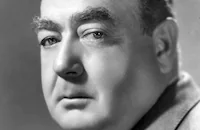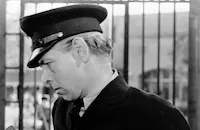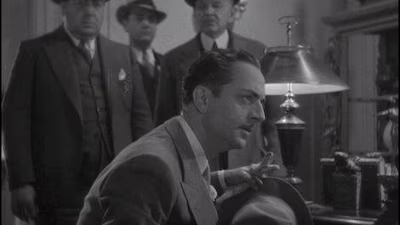The Kennel Murder Case

Brief Synopsis
Cast & Crew
Michael Curtiz
William Powell
Mary Astor
Eugene Pallette
Ralph Morgan
Robert Mcwade
Film Details
Technical Specs

Synopsis
When wealthy, heartless Archer Coe is found dead, ace detective Philo Vance joins forces with his nemesis, police sergeant Ernest Heath, to solve the case. What first appears to be suicide turns out to be not only Coe's murder, but also the killing of his brother Brisbane. There are several suspects, each with a strong motive: Hilda Lake, Coe's ward, who deeply disliked her guardian and resented his control of her money; Sir Thomas MacDonald, who planned to marry Hilda, and whose outrage when his prize show dog was killed made him threaten Coe with revenge; Raymond Wrede, Coe's secretary, who was also in love with Hilda and believed that Coe stood between him and happiness; and Doris Delafield, Coe's mistress, who was about to run away with her art dealer boyfriend, Eduardo Grassi, when Coe caught them together, canceled a big business deal with Grassi and ended his relationship with Doris. During the investigation, Liang, Coe's cook, who had been helping his employer illegally purchase ancient Chinese art, is found hiding evidence and is added to the list of suspects. When an attempt is made on Sir Thomas' life, Vance links that incident with the other crimes and with the help of Sir Thomas and a Doberman pinscher, Vance stages a scene to induce the real killer to strike again. The murderer, Wrede, confesses and Vance skillfully explains the intricate plotting of the crime, leaving Hilda and Sir Thomas free to marry.

Director

Michael Curtiz
Cast

William Powell

Mary Astor

Eugene Pallette

Ralph Morgan

Robert Mcwade

Robert Barrat

Frank Conroy

Etienne Girardot
James Lee

Paul Cavanagh

Arthur Hohl

Helen Vinson

Jack La Rue

Henry O'neill
Spencer Charters
Charles Wilson
Don Brody
George Chandler
Wade Boteler
Crew
Al Alborn
Charles Althouse
Ruth Brownson
Arthur G. Collins
Owen Crompton
John Ellis
Leo F. Forbstein
Larry Kennedy
Robert N. Lee
William Mcgann
Harold Mclernon
Peter Milne
Jack Okey
Orry-kelly
Limey Plews
Robert Presnell
Robert Presnell
Kurt Rayfeld
William Rees
William Whitley

Photo Collections
Videos
Movie Clip




Trailer
Hosted Intro
Film Details
Technical Specs

Articles
The Kennel Murder Case
As with his other films at Warner's, Curtiz kept things moving in The Kennel Murder Case. He used dissolves and wipes to race from scene to scene, while within scenes he used a mobile camera to cover up the genre's inevitable talkiness. He also was proving expert at getting actors to do their best. Powell gave his best performance of the year as Vance, with strong support from leading lady Mary Astor and sidekick Eugene Pallette. Thanks to Curtiz, the picture turned a surprising profit of almost $400,000, which helped him win better assignments at the studio. Two years later, Warner's would trust him with their first swashbuckler, Captain Blood, one of the studio's most lavish films of the thirties.
For Powell, The Kennel Murder Case seemed something of a setback. He had already played Vance in three early talkies at Paramount, starting with The Canary Murder Case in 1929. Two years later, he left Paramount for Warners, with the promise of better material, script approval and more money. But during his time there, he only appeared in one other film of distinction, the tragic romance One Way Passage (1932), with frequent co-star Kay Francis. Disappointed with his prospects at Warners, he would jump ship for MGM in 1934. That very year MGM would transform him into one of Hollywood's top stars as yet another sophisticated sleuth, Nick Charles in The Thin Man, with Myrna Loy as his partner in marriage and mystery.
Powell's move to MGM hardly marked the end for Philo Vance, who would resurface at Warners, Paramount and even MGM. Warren Williams took over the role at Warners in The Dragon Murder Case (1934), then moved to Paramount in 1939 for The Gracie Allen Murder Case, a story Van Dine wrote for the popular comedienne. MGM had other plans for Powell, so they cast Paul Lukas in The Casino Murder Case (1935) and Edmund Lowe in The Garden Murder Case (1936). Warners would remake The Kennel Murder Case as Calling Philo Vance in 1940, this time with James Stephenson as the sleuth.
Producer: Robert Presnell
Director: Michael Curtiz
Screenplay: Robert N. Lee, Peter Milne, Robert Presnell
Based on The Return of Philo Vance by S.S. Van Dine
Cinematography: William Reese
Art Direction: Jack Okey
Music: Bernhard Kaun (uncredited)
Costume Design: Orry-Kelly
Cast: William Powell (Philo Vance), Mary Astor (Hilda Lake), Eugene Pallette (Sgt. Heath), Ralph Morgan (Raymond Wrede), Jack LaRue (Eduardo Grassi), Helen Vinson (Doris Delafield), Robert McWade (District Attorney John F.X. Markham).
BW-74m.
by Frank Miller

The Kennel Murder Case
Quotes
Trivia
Notes
A news item in Film Daily notes that Ralph Bellamy was signed to a role in this picture, but he was not in the released film. According to Warner Bros. records, initial casting included Hugh Herbert as Dr. Doremus, George Blackwood as Bruce MacDonald and Claire Dodd as Doris Delafield. William Powell's onscreen credit reads "William Powell returns as Philo Vance in The Kennel Murder Case." Modern sources include Harry Allen (Dog trainer), Milton Kibbee (Charlie Adler), Leo White (Desk clerk), James Burke (Policeman) and Monte Vandergrift (Detective) in the cast. Among the many movies featuring Philo Vance were two made by Paramount in 1929: The Canary Murder Case, directed by Malcolm St. Clair and starring William Powell; and The Greene Murder Case, directed by Frank Tuttle and also starring William Powell. Two more were made in 1930: The Bishop Murder Case, starring Basil Rathbone as Philo Vance, directed by Nick Grinde for M-G-M; and The Benson Murder Case, starring William Powell and directed by Frank Tuttle for Paramount. The 1930 Paramount film Paramount on Parade featured Powell as Vance in a spoof of detective mysteries called "Murder Will Out" (see AFI Catalog of Feature Films, 1921-30; F2.0352, F2.0424, F2.0760, F2.2254 and F2.4133). Several other "Philo Vance" films were made by various studios during the 1930s and 1940s. For additional information on films featuring the character, consult the Series Index.
















